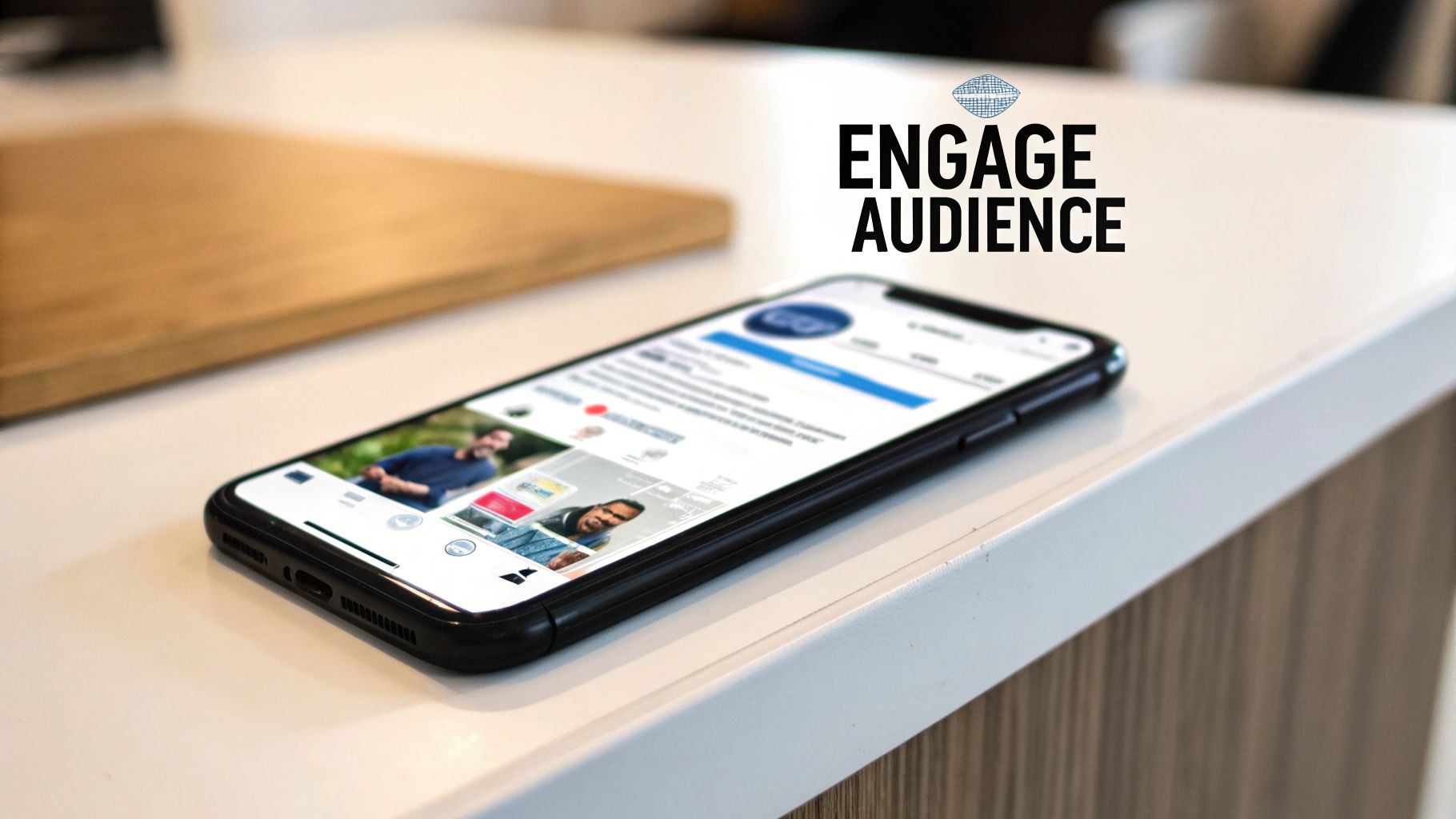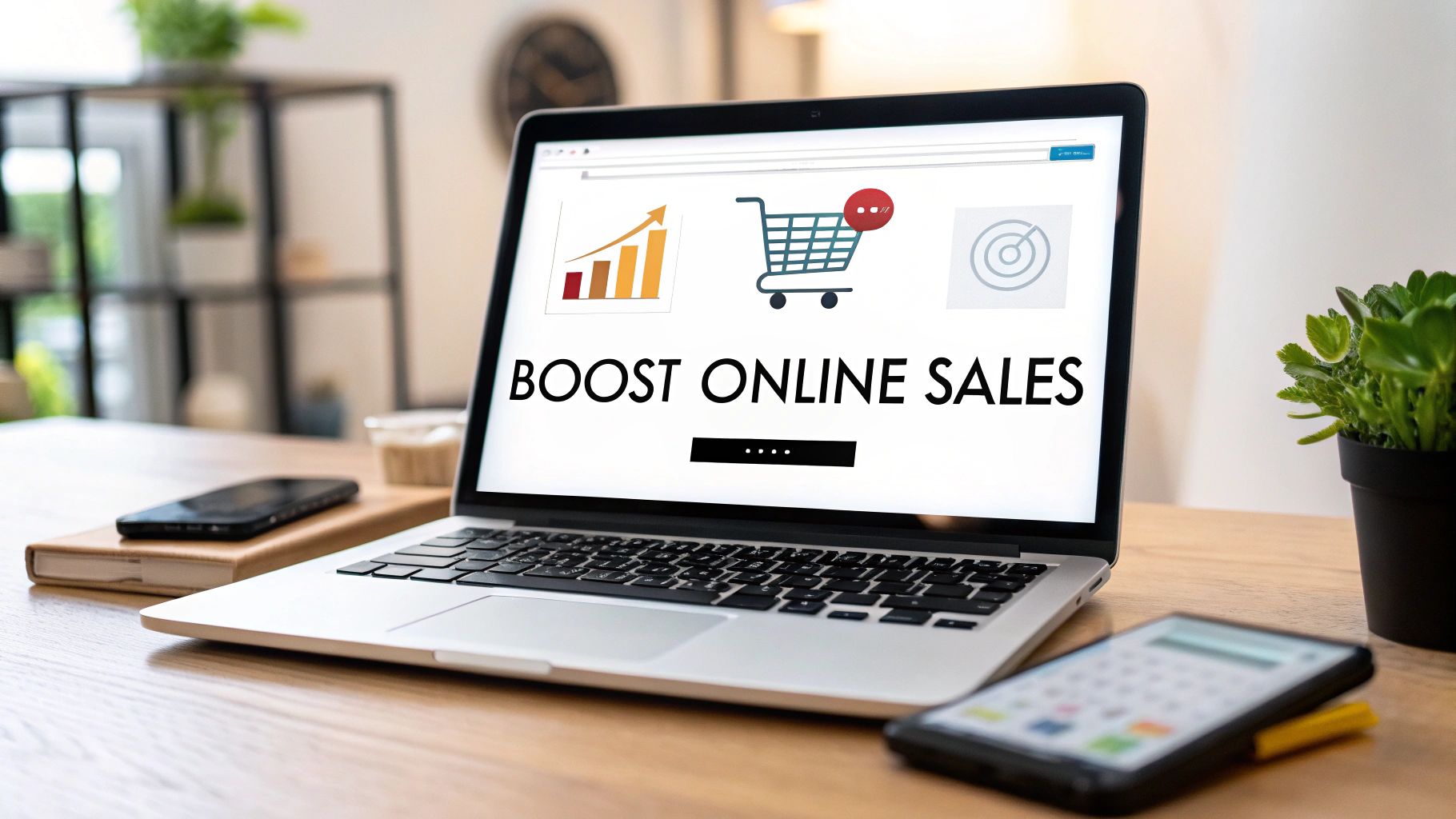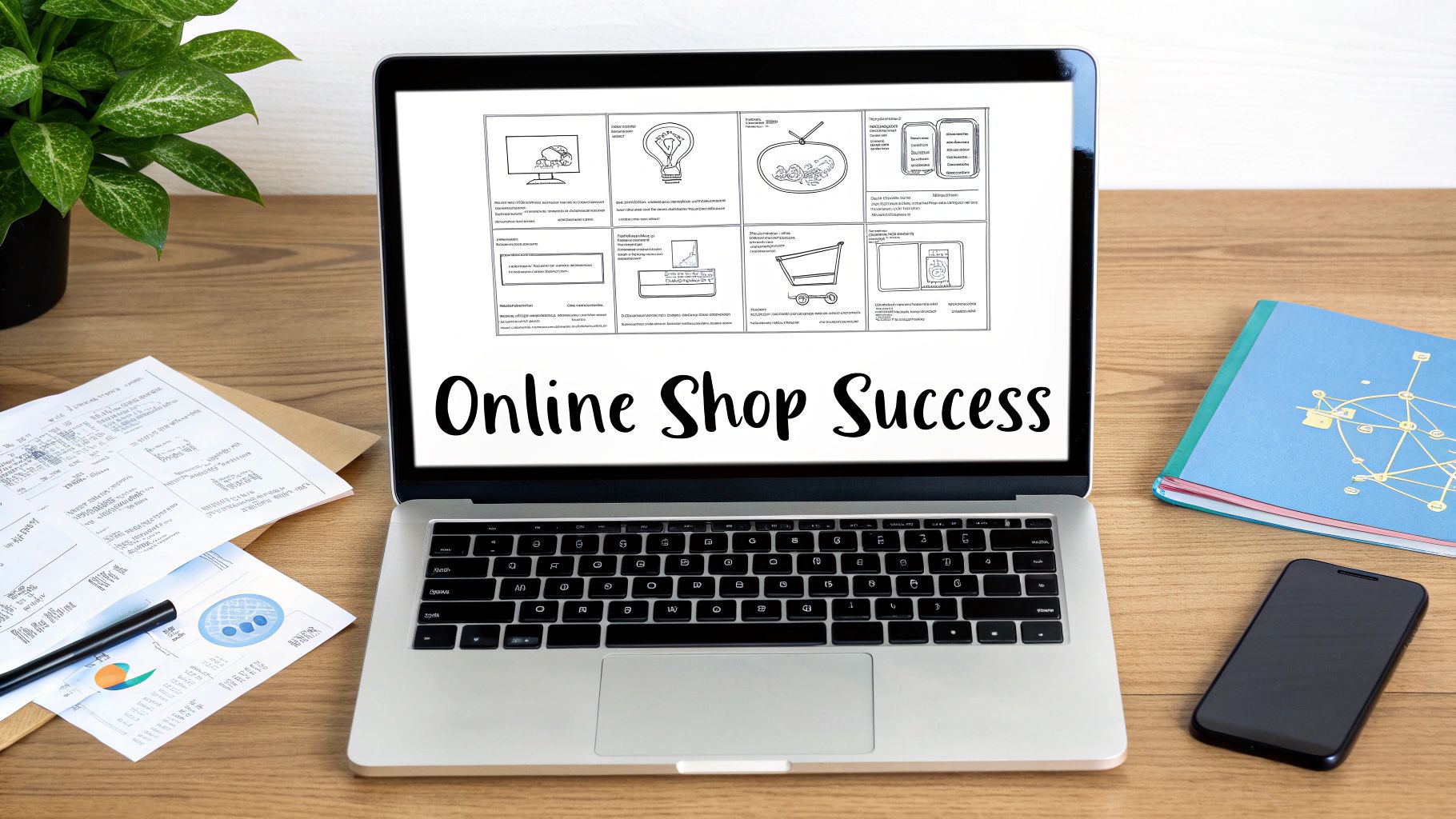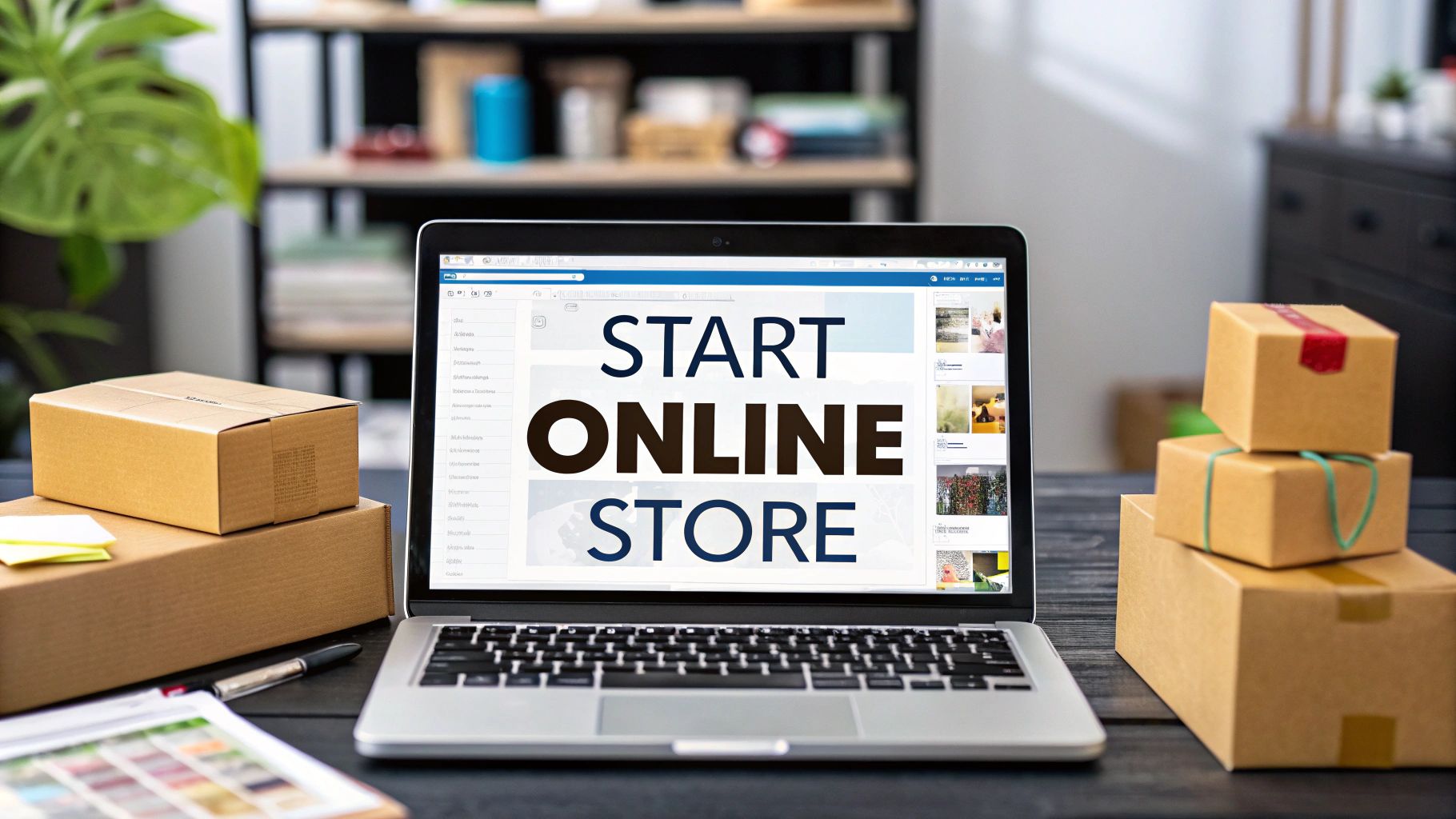
10 Proven Methods for Promoting a Website in 2025
0
1
0
Building a brilliant website is just the first step. The real challenge is getting it in front of the right audience. In a crowded digital marketplace, effectively promoting a website is the critical factor that separates a successful online presence from an invisible one. Without a robust promotion strategy, even the most beautifully designed site will fail to attract traffic, generate leads, or drive sales. This is where a targeted, multi-channel approach becomes essential for sustainable growth.
This comprehensive guide moves beyond generic advice to provide a detailed roundup of ten powerful, battle-tested strategies that deliver tangible results, 10 Proven Methods for Promoting a Website in 2025. We're not just telling you what to do; we're showing you how to do it. You will discover actionable steps for implementing everything from foundational Search Engine Optimisation (SEO) and compelling Content Marketing to sophisticated Pay-Per-Click (PPC) campaigns and strategic Influencer Partnerships.
Each method is broken down with specific implementation details, practical examples, and expert insights to help you choose the right mix for your business and budget. Whether you're a startup founder, an e-commerce entrepreneur, or a marketing professional, these strategies provide a clear blueprint for promoting a website and achieving your growth goals. You’ll learn how to build lasting visibility, engage your target audience, and turn website visitors into loyal customers. Let’s dive into the techniques that will transform your website from a passive digital brochure into an active, traffic-generating asset.
1. Search Engine Optimisation (SEO)
Search Engine Optimisation (SEO) is the foundational practice of structuring and refining your website to achieve higher rankings in search engine results pages (SERPs). This organic approach to promoting a website focuses on attracting qualified traffic from search engines like Google and Bing by demonstrating your site's relevance and authority for specific user queries.
Effective SEO is not a one-time task but a continuous process involving on-page, off-page, and technical optimisations. Companies like HubSpot, which ranks for over 2.8 million keywords, and Canva, with visibility for more than 48 million keywords globally, showcase the immense potential of a well-executed SEO strategy. Their success stems from consistently creating valuable content and ensuring their websites meet search engine standards.
Why It's a Core Strategy
SEO is crucial because it targets users who are actively searching for solutions, products, or information that you offer. This results in higher-quality traffic compared to interruptive advertising. By securing top positions in search results, you build brand credibility and establish your website as a trusted resource, creating a sustainable source of leads and sales over the long term.
Actionable Steps for Implementation:
Focus on Search Intent: Go beyond simple keywords. Understand why a user is searching for a particular phrase. Are they looking to buy, learn, or find a specific website? Tailor your content to satisfy that intent.
Target Long-Tail Keywords: Instead of competing for broad terms like "shoes," target more specific, lower-competition phrases like "best waterproof running shoes for men UK." These queries often have higher conversion rates.
Build High-Quality Backlinks: Earn links from reputable, relevant websites in your industry. This acts as a vote of confidence to search engines, significantly boosting your site's authority.
Optimise Page Experience: Ensure your website loads quickly, is mobile-friendly, and provides a secure connection (HTTPS). Google's Core Web Vitals are key metrics for evaluating user experience.
Refresh Existing Content: Regularly update your old blog posts and pages with new information, statistics, and examples. This signals to search engines that your content is still relevant and valuable.
To gain a deeper understanding of the technical and strategic elements involved, you can [master website optimisation for search engines](https://www.baslondigital.com/post/master-website-optimization-for-search-engines) with our comprehensive guide.
Ready to climb the search rankings? Start by conducting a thorough SEO audit of your website to identify key areas for improvement.
2. Content Marketing
Content marketing is the strategic practice of creating and distributing valuable, relevant, and consistent content to attract and retain a clearly defined audience. This long-term approach to promoting a website positions your brand as an authority in its niche, naturally driving traffic through blog posts, in-depth guides, videos, and podcasts that educate, entertain, or solve specific problems for your target audience.

This method moves beyond direct selling, focusing instead on building trust and relationships. For instance, Buffer's transparent, educational blog attracts over 2.3 million monthly visitors by offering deep insights into social media marketing. Similarly, Ahrefs draws more than 800,000 monthly visitors by publishing expert-level SEO guides, establishing themselves as the go-to resource in their field.
Why It's a Core Strategy
Content marketing is fundamental because it builds a lasting asset for your business. Unlike paid ads, which stop delivering traffic once the budget runs out, a high-quality piece of content can attract organic visitors for years. It fuels your SEO efforts, provides material for social media, and nurtures potential customers through their buying journey, establishing credibility and fostering loyalty long before they are ready to make a purchase.
Actionable Steps for Implementation:
Establish Content Pillars: Build your strategy around core topics central to your niche. This ensures your content remains focused and consistently addresses your audience's primary interests.
Prioritise Quality Over Quantity: One exceptional, well-researched article or video will deliver far more value and traffic than ten mediocre pieces. Focus on creating the best resource available on a given topic.
Develop Content for Each Buyer Stage: Create content that addresses audience needs at the awareness, consideration, and decision stages of their journey, guiding them from initial interest to final purchase.
Repurpose Your Best Content: Maximise your efforts by transforming a successful blog post into a video, an infographic, a podcast episode, or a series of social media updates to reach a wider audience.
Use Data and Original Research: Create unique, linkable assets by conducting surveys or analysing industry data. This type of content attracts high-quality backlinks, significantly boosting your site’s authority.
To ensure your efforts translate into business results, discover [how to write website content that converts](https://www.baslondigital.com/post/how-to-write-website-content-that-converts) with our expert guidance.
Ready to turn your website into a traffic-generating resource? Begin by outlining a content calendar based on your core business pillars.
3. Social Media Marketing
Social Media Marketing involves using platforms like Instagram, Facebook, LinkedIn, and TikTok for promoting a website, engaging with your audience, and driving traffic. This strategy blends organic content creation with paid advertising to build brand awareness, foster a loyal community, and convert followers into website visitors and, ultimately, customers.

The power of social media is evident in major brand success stories. Glossier built a billion-dollar beauty empire primarily through its community-driven Instagram presence, while Gymshark leveraged fitness influencers to achieve a massive valuation. These examples highlight how a strategic social media presence can generate immense brand visibility and direct traffic, making it a vital channel for website promotion.
Why It's a Core Strategy
Social media is a core strategy because it allows you to connect with your audience where they spend a significant amount of their time. It offers a direct line of communication to build relationships, gather feedback, and establish brand personality. Unlike more passive methods, it enables proactive engagement, turning your brand into an active participant in conversations relevant to your industry and effectively funnelling interested users back to your site.
Actionable Steps for Implementation:
Select the Right Platforms: Don't try to be everywhere. Focus on two or three platforms where your target audience is most active. A B2B company might prioritise LinkedIn, while an e-commerce fashion brand would focus on Instagram and Pinterest.
Post Consistently and Strategically: Develop a content calendar to maintain a regular posting schedule. Use platform analytics to determine the optimal times your audience is online and engaged.
Utilise Platform-Native Features: Boost your organic reach by using features like Instagram Reels, Stories, and LinkedIn articles. Algorithms often favour content created using their newest tools.
Engage Authentically: Social media is a two-way street. Respond to comments, answer questions in messages, and participate in relevant conversations to build a genuine community around your brand.
Drive Traffic with Clear CTAs: Every post should have a purpose. Include clear calls-to-action (CTAs) and direct links in your bio, stories, or posts to guide followers to your website.
To streamline your efforts and manage multiple accounts effectively, you can explore the [top social media management tools for UK businesses](https://www.baslondigital.com/post/top-11-best-social-media-management-tools-for-uk-2025) and find the right platform for your needs.
Ready to turn followers into website traffic? Begin by analysing your audience to choose the most impactful social platforms for your brand.
4. Email Marketing
Email marketing is the strategic practice of building a subscriber list and sending targeted campaigns directly to their inboxes to drive traffic back to your website. This direct line of communication allows you to nurture relationships, promote content, and guide users towards conversion through newsletters, automated sequences, and personalised promotional offers.

It remains one of the highest-performing digital marketing channels, with an average return on investment often cited between £36 and £42 for every £1 spent. Media companies like TheSkimm and Morning Brew built entire empires on the back of their newsletters, attracting millions of dedicated subscribers. Similarly, BuzzFeed's newsletters are a powerful tool for promoting a website, reportedly driving a significant portion of their daily traffic.
Why It's a Core Strategy
Unlike social media or search, email marketing gives you direct, unmediated access to your audience. You own your list, making it a stable and reliable asset that isn't subject to algorithm changes. This makes it an incredibly effective channel for building loyalty and encouraging repeat visits, transforming one-time visitors into a dedicated community that consistently engages with your content and offerings.
Actionable Steps for Implementation:
Offer a Valuable Lead Magnet: Encourage sign-ups by offering a free, high-value resource like an ebook, checklist, or exclusive guide. This provides an immediate incentive for visitors to share their email address.
Segment Your Audience: Don't send the same email to everyone. Group subscribers based on their interests, past purchases, or on-site behaviour to send highly relevant and personalised content.
Craft Compelling Subject Lines: Your subject line is crucial. Keep it concise (30-50 characters is often optimal), create curiosity, and clearly communicate the value inside the email to boost open rates.
Include a Clear Call-to-Action (CTA): Every email should have a purpose. Use prominent buttons or links that clearly guide subscribers on what to do next, whether it’s reading a blog post or viewing a new product.
Optimise for Mobile Devices: With over 70% of emails now opened on mobile, ensure your campaigns are responsive. Use a single-column layout, large fonts, and easily tappable buttons for the best user experience.
Ready to turn your website visitors into a loyal community? Start building your email list today by creating an irresistible lead magnet.
5. Pay-Per-Click Advertising (PPC)
Pay-Per-Click (PPC) advertising is a powerful digital marketing model where you pay a fee each time one of your ads is clicked. Instead of earning visits organically, this method of promoting a website involves buying visibility on search engines like Google and social media platforms. This includes search ads at the top of results pages, display ads across various websites, and video ads on platforms like YouTube.
PPC allows for immediate traffic and precise targeting. Giants like Amazon, which spends billions annually on ads, and Airbnb, which used Google Ads to scale from a small startup into a global brand, demonstrate the immense power of a well-optimised PPC strategy. It offers unparalleled control over budget, audience, and messaging, delivering measurable results quickly.
Why It's a Core Strategy
PPC is crucial because it provides instant visibility and targets users with high commercial intent, especially through search ads. While SEO builds long-term authority, PPC delivers immediate traffic and leads, making it ideal for product launches, promotions, or quickly testing market viability. This direct approach offers a clear return on investment and allows you to compete with larger players from day one.
Actionable Steps for Implementation:
Start with High-Intent Keywords: Begin your campaigns by targeting search queries that indicate a user is ready to buy or take action, such as "emergency plumber near me" or "buy organic dog food online."
Utilise Negative Keywords: Actively build a list of negative keywords to prevent your ads from showing for irrelevant searches. This simple step saves money and improves your campaign's relevance.
Create Tightly Themed Ad Groups: Organise your keywords into small, highly specific ad groups. This allows you to write more relevant ad copy, which improves your Quality Score and lowers your cost-per-click.
Write Compelling Ad Copy: Your ad must grab attention and offer a clear value proposition. Include a strong call-to-action (CTA) like "Shop Now & Get 20% Off" or "Request a Free Quote Today."
Optimise Your Landing Pages: Ensure the page users land on after clicking your ad is directly relevant to the ad copy and keyword. A seamless experience is vital for converting clicks into customers.
Implement Conversion Tracking: Before spending a single penny, set up conversion tracking to accurately measure which ads and keywords are driving valuable actions, such as sales or form submissions.
Ready to generate immediate, targeted traffic? Launch your first PPC campaign today to capture high-intent customers actively searching for your solutions.
6. Influencer Marketing & Partnerships
Influencer marketing leverages individuals with established audiences to promote your website to their followers. This strategy involves collaborating with social media personalities, bloggers, and industry experts who can authentically recommend your brand to their engaged communities, driving targeted traffic and building social proof.
This approach moves beyond traditional advertising by tapping into the trust influencers have built with their audience. Brands like Daniel Wellington, which built a multi-million-pound empire primarily through Instagram collaborations, and Skillshare, which partners with educational YouTubers to drive millions of website visits, exemplify the power of this strategy. These successes show how a credible third-party endorsement can be a powerful method for promoting a website.
Why It's a Core Strategy
Influencer marketing is effective because it uses authentic storytelling and trusted recommendations to cut through the noise of digital advertising. When an influencer's audience aligns with your target market, their endorsement acts as a powerful, personalised referral. This method not only drives immediate traffic but also enhances brand credibility and can generate high-quality, user-generated content for your own marketing channels.
Actionable Steps for Implementation:
Prioritise Engagement Over Follower Count: Focus on micro-influencers (10k-100k followers) who often have higher engagement rates and a more dedicated community. Their recommendation can feel more genuine and yield a better return on investment.
Ensure Audience Alignment: Thoroughly vet potential partners to confirm their audience demographics, interests, and values match your ideal customer profile. Misalignment can lead to a wasted budget and damage your brand's reputation.
Grant Creative Freedom with Clear Guidelines: Provide influencers with a clear brief outlining key messages and goals, but allow them the creative freedom to present your website in a way that feels authentic to their personal brand and audience.
Use Unique Tracking Links: Implement unique UTM links or discount codes for each influencer. This allows you to accurately measure the traffic, conversions, and overall ROI from each partnership.
Build Long-Term Relationships: Instead of one-off campaigns, cultivate lasting partnerships. Long-term collaborations build deeper brand association and feel more genuine to the audience over time.
Ready to harness the power of trusted voices? Start by identifying a small group of micro-influencers whose content and audience perfectly match your brand.
7. Guest Blogging & Content Syndication
Guest blogging and content syndication are powerful strategies for promoting a website by leveraging the authority and audience of established third-party platforms. Guest blogging involves writing original content for other websites in your niche, while syndication focuses on republishing your existing content on larger publications to expand its reach.
This dual approach allows you to tap into pre-existing traffic streams and build your brand's reputation. For instance, Buffer famously acquired its first 100,000 users in just nine months, largely through a strategic guest blogging campaign. Similarly, marketing expert Neil Patel built his personal brand by publishing thousands of guest posts, demonstrating the scalability of this method for establishing industry authority.
Why It's a Core Strategy
This strategy is essential because it places your brand directly in front of a relevant, engaged audience you might not otherwise reach. It serves as a powerful endorsement, as the host publication is essentially vouching for your expertise. This builds trust, drives high-quality referral traffic, and generates valuable backlinks, which are crucial for improving your own website’s SEO performance and credibility over time.
Actionable Steps for Implementation:
Target Relevant Publications: Identify blogs and online magazines that your ideal customers read. Focus on relevance and engagement over sheer domain authority.
Provide Genuine Value: Pitch and write content that is genuinely helpful and informative, not just a thinly-veiled advertisement. Your primary goal is to solve a problem for the reader.
Include Contextual Links: Naturally embed one or two links back to relevant resources on your own site within the body of the article. Avoid overt self-promotion.
Use Canonical Tags for Syndication: When republishing content, ensure the publisher uses a canonical tag pointing to the original article on your site. This tells search engines which version is the original, preventing duplicate content issues.
Build Editor Relationships: Nurture your connections with editors. A good relationship can lead to recurring opportunities and a more streamlined publication process.
Ready to expand your reach? Start by creating a target list of 10-15 relevant publications and brainstorming unique article ideas tailored to their audiences.
8. Online Communities & Forum Marketing
Online community and forum marketing is the strategic practice of engaging with your target audience where they naturally gather online. This involves participating in platforms like Reddit, Quora, industry-specific forums, Facebook Groups, and Discord servers, not to sell, but to provide genuine value, answer questions, and build a reputation as a helpful expert.
This organic approach to promoting a website centres on relationship-building. For instance, Notion built its early user base by engaging with productivity enthusiasts on Reddit and Product Hunt. Similarly, Brian Dean of Backlinko has famously driven over 100,000 visitors to his site by providing comprehensive, high-value answers on Quora that naturally reference his content. These successes highlight how authentic participation can cultivate a loyal following and direct relevant traffic to your site.
Why It's a Core Strategy
This method is powerful because it connects you directly with a pre-qualified, highly engaged audience actively discussing topics relevant to your niche. Instead of interrupting potential customers, you become a trusted part of their community. This builds immense credibility and brand loyalty, turning community members into advocates and driving warm, high-intent traffic to your website over the long term.
Actionable Steps for Implementation:
Prioritise Value Over Promotion: Adopt a "give, give, give, ask" mentality. Contribute valuable insights and help others extensively before ever mentioning your own website or products.
Optimise Your Profile: Where permitted, include a link to your website in your profile biography. This provides a non-intrusive way for interested users to discover you.
Target Niche Communities: Focus your efforts on 2-3 highly relevant communities rather than spreading yourself thin. Becoming a recognised, regular contributor in a smaller forum is more effective than being a stranger in many.
Answer Questions Comprehensively: When you find a relevant discussion, write detailed, helpful answers. If you have a blog post or resource that provides further depth, you can link to it as a natural next step for the reader.
Respect Community Rules: Every community has its own guidelines regarding self-promotion. Read and respect them meticulously to avoid being banned and to maintain your credibility.
Ready to build your brand from the ground up? Identify two relevant online communities today and start contributing by answering a question or sharing a helpful tip.
9. Video Marketing (YouTube & Video SEO)
Video marketing is the strategic creation and distribution of video content to engage audiences, build brand presence, and drive traffic. This method leverages platforms like YouTube, the world's second-largest search engine, to connect with users through tutorials, product demonstrations, and behind-the-scenes stories, making it a powerful way of promoting a website through visual storytelling.
The impact of a strong video strategy is undeniable. Ahrefs, a leading SEO tool provider, drives over 20,000 monthly website visits directly from its educational YouTube channel. Similarly, BuzzFeed's Tasty brand built a massive following and generated enormous web traffic through its viral, bite-sized recipe videos. These examples prove that video is not just for entertainment; it is a significant channel for customer acquisition and brand building.
Why It's a Core Strategy
Video marketing is essential because it captures attention more effectively than text alone and builds a deeper, more personal connection with your audience. Videos that appear in Google search results provide an additional, highly visible entry point to your website. This approach builds trust and authority, as viewers can see and hear from you directly, making your brand more human and relatable.
Actionable Steps for Implementation:
Optimise for Search: Treat your YouTube videos like web pages. Use relevant keywords in your titles, descriptions, and tags to improve discoverability on both YouTube and Google.
Create Compelling Thumbnails: Your thumbnail is your video's first impression. Design custom, high-contrast thumbnails with clear text and expressive faces to maximise click-through rates.
Prioritise Your Website Link: Place a direct link to your website or a relevant landing page within the first two lines of your video description, ensuring it's visible without needing to click "show more."
Use Clear Calls-to-Action (CTAs): Verbally tell viewers what to do next (e.g., "visit our website for the full guide") and use YouTube's end screens and cards to create clickable links to your site.
Repurpose Existing Content: Transform your popular blog posts, guides, or case studies into engaging video scripts. This maximises the value of your existing content and reaches a new audience segment.
Ready to turn viewers into website visitors? Start by outlining your first three educational videos based on your most popular blog posts.
10. Strategic Link Building & Digital PR
Strategic link building is the process of acquiring high-quality backlinks from other authoritative websites to your own. This practice is a cornerstone of promoting a website, as these links act as endorsements, signalling to search engines like Google that your content is credible and valuable. Digital PR expands on this by combining traditional public relations with content marketing and SEO to earn high-authority media coverage, brand mentions, and powerful backlinks.
This strategy has delivered phenomenal results for many brands. For example, Ahrefs published an original study on Google click-through rates that subsequently earned over 13,000 backlinks from reputable domains. Similarly, Brian Dean of Backlinko popularised the "Skyscraper Technique," a method of creating superior content to attract links, which famously generated thousands of visitors in just two weeks. These examples highlight how creating newsworthy, data-driven assets can fuel both brand authority and organic traffic.
Why It's a Core Strategy
Link building and digital PR are crucial because they directly impact your website's domain authority, a key factor in search engine rankings. While on-page SEO makes your site understandable to search engines, backlinks provide the external validation needed to climb the rankings for competitive keywords. Furthermore, a successful digital PR campaign places your brand in front of new, relevant audiences, driving high-quality referral traffic and building brand trust far beyond what paid ads can achieve alone.
Actionable Steps for Implementation:
Create "Linkable Assets": Develop content that others will want to reference, such as original research, free online tools, comprehensive guides, or compelling infographics. This gives journalists and bloggers a tangible reason to link to you.
Leverage HARO and Qwoted: Use services like Help a Reporter Out (HARO) to respond to daily queries from journalists. Providing an expert quote is a straightforward way to earn mentions and backlinks from major news outlets.
Analyse Competitor Backlinks: Use SEO tools to see which websites are linking to your competitors. Reach out to these same sites and present your superior content as an alternative or additional resource.
Fix Unlinked Brand Mentions: Set up alerts to find where your brand is mentioned online without a link. Contact the publisher and politely request that they add a hyperlink back to your website.
Personalise Your Outreach: Avoid generic, mass email templates. Craft personalised emails that show you have researched the person's work and explain the specific value your content offers their audience.
Start building your site's authority today by identifying one key "linkable asset" you can create, such as an industry survey or a helpful calculator.
10 Website Promotion Strategies Compared
Strategy | Implementation Complexity (🔄) | Resource Requirements (⚡) | Expected Outcomes (📊) | Ideal Use Cases (💡) | Key Advantages (⭐) |
|---|---|---|---|---|---|
Search Engine Optimization (SEO) | High 🔄 — technical, ongoing cross-discipline work | Medium–High ⚡ — content, dev, link outreach | High 📊 — sustainable organic traffic (3–12+ months) | Long-term growth, lead generation, content sites | Sustainable traffic; high-intent leads; authority |
Content Marketing | Medium–High 🔄 — strategy + consistent production | High ⚡ — writers, designers, research ($2k–10k/mo typical) | High 📊 — brand authority, supports SEO; slow burn | Brand building, funnel nurture, evergreen assets | Repurposable content; trust & thought leadership |
Social Media Marketing | Medium 🔄 — platform-specific tactics, daily management | Medium ⚡ — content creation + ad budget for scale | Medium–High 📊 — awareness & engagement; variable ROI | Awareness campaigns, community growth, launches | Broad reach; real-time engagement; targeting options |
Email Marketing | Medium 🔄 — list building, segmentation, compliance | Low–Medium ⚡ — ESP tools, content, time to grow list | High 📊 — repeat traffic & conversions; excellent ROI | Nurture sequences, promotions, retention campaigns | Owned channel; personalization at scale; measurable ROI |
Pay-Per-Click Advertising (PPC) | Medium–High 🔄 — campaign setup, ongoing optimization | High ⚡ — ad spend + skilled management | Immediate 📊 — fast traffic and conversions; stops when budget ends | Immediate traffic, offer testing, sales-driven goals | Instant visibility; precise targeting; measurable ROI |
Influencer Marketing & Partnerships | Medium 🔄 — discovery, negotiation, creative alignment | Medium–High ⚡ — fees, product costs, campaign management | Medium–High 📊 — rapid awareness; ROI varies by partner | Rapid brand awareness, social proof, new audience reach | Third-party trust; authentic content; scalable reach |
Guest Blogging & Content Syndication | Medium 🔄 — pitching, tailored writing, editorial rules | Low–Medium ⚡ — time investment; occasional fees | Medium 📊 — referral traffic & backlinks; often temporary spikes | Authority building, backlink acquisition, niche reach | High-authority backlinks; audience access; low monetary cost |
Online Communities & Forum Marketing | Low–Medium 🔄 — cultural fit, consistent participation | Low ⚡ — primarily time investment | Variable 📊 — targeted referrals; potential viral spikes | Startups, niche products, market research, trust-building | Highly targeted; low-cost; builds authority and feedback |
Video Marketing (YouTube & Video SEO) | High 🔄 — production, editing, channel strategy | High ⚡ — equipment, editing, time (6–12+ months to scale) | High 📊 — strong engagement; long shelf life; search visibility | Tutorials, demos, personal branding, educational content | High engagement; SEO visibility on YouTube/Google; repurposable |
Strategic Link Building & Digital PR | High 🔄 — outreach, research, relationship-building | Medium–High ⚡ — time, PR tools, possible agency costs | High 📊 — improved rankings, referral traffic, brand mentions | Competitive SEO growth, authority building, large campaigns | High-quality backlinks; media coverage; compounding SEO value |
Start Promoting Your Website with Confidence
Navigating the landscape of digital promotion can feel overwhelming, but as we've explored, the journey from obscurity to online authority is a well-trodden path. We've delved into a comprehensive arsenal of ten powerful strategies, from the foundational pillars of Search Engine Optimisation and Content Marketing to the dynamic outreach of Social Media and Influencer Partnerships. You now have a detailed blueprint for elevating your online presence.
The true secret to successfully promoting a website isn't about mastering every single one of these tactics overnight. Instead, it's about strategic implementation. A local service business might find immense value in mastering local SEO and building a robust email list, while an e-commerce brand might prioritise Pay-Per-Click advertising and video marketing on platforms like YouTube to showcase its products. The key is to select the channels where your target audience is most active and engaged.
Your Core Takeaways and Actionable Next Steps
Let's distil our journey into a clear, actionable plan. The most crucial takeaway is that these strategies are not isolated islands; they are interconnected components of a holistic digital marketing ecosystem. Your high-quality blog content fuels your SEO efforts, provides valuable material for your social media channels, and gives you compelling reasons to connect with your email subscribers.
To move forward with purpose, consider these immediate next steps:
Conduct an Audit: Start by assessing your current situation. Where does your website currently stand in terms of SEO? What is your social media presence like? A clear understanding of your starting point is essential for measuring future success.
Select Your 'Power Trio': Instead of trying to do everything at once, choose three strategies from this guide that best align with your business goals, resources, and target audience. For example, you might focus on SEO, Content Marketing, and Email Marketing as your foundational trio.
Create a 90-Day Plan: Set realistic, measurable goals for the next three months. This could be publishing two high-quality blog posts per month, increasing your organic traffic by 10%, or gaining 200 new email subscribers. A short-term plan fosters focus and creates momentum.
Embrace Analysis: Consistently track your performance using tools like Google Analytics. Pay close attention to which channels are driving the most traffic and conversions. This data-driven approach allows you to pivot your strategy, doubling down on what works and refining what doesn't.
The Long-Term Vision: Building a Digital Asset
Ultimately, the goal of promoting a website is to build a sustainable, traffic-generating asset for your business. It’s about creating a digital headquarters that consistently attracts new leads, nurtures potential customers, and establishes your brand as a trusted authority in your industry. Each piece of content you create, every backlink you earn, and every new subscriber you gain is a brick in the foundation of your digital success.
Patience and consistency are your greatest allies. The results won't appear overnight, but with persistent effort and a commitment to providing genuine value to your audience, your website will transform from a simple online placeholder into a powerful engine for growth. The strategies outlined here are your tools; now it’s time to start building with confidence.
Ready to put these promotional strategies into action but need a stunning, optimised website as your foundation? At Baslon Digital, we specialise in creating high-performance Wix websites designed to attract, engage, and convert your ideal customers. Contact us today for a free consultation and let's build the powerful online presence your business deserves.


